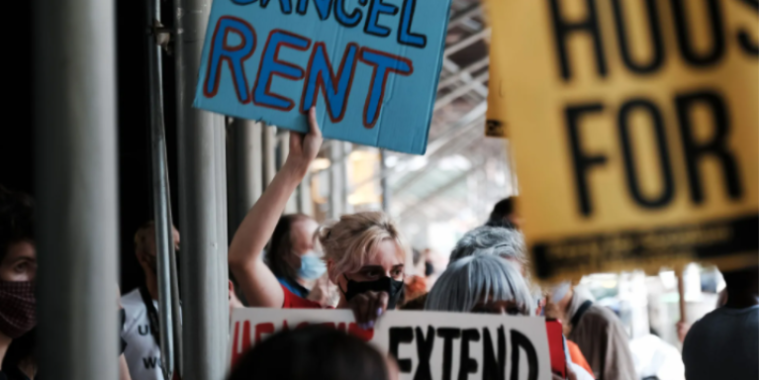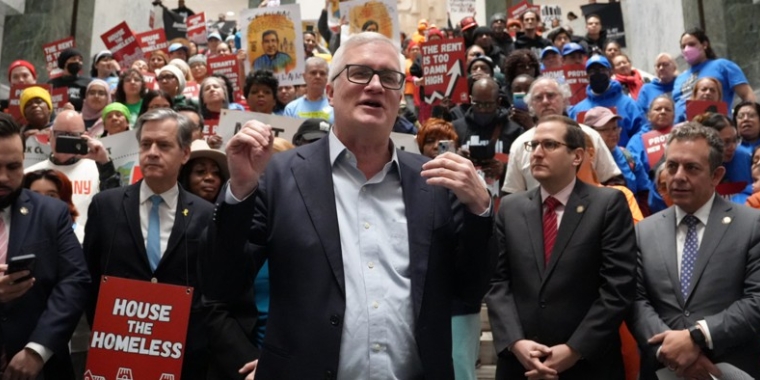New Yorker Magazine: Andrew Cuomo Left Behind a Rent-Relief Debacle

The #CancelRent movement was born out of activists’ fear that rent debts would be allowed to accrue for however long it took the economy to rebound. Photograph by Spencer Platt / Getty
On June 1st, New York began accepting applications for its Emergency Rental Assistance Program, or E.R.A.P., a $2.7 billion bailout fund for hundreds of thousands of renters and landlords who lost jobs or income or both during the pandemic. The money, which represented New York’s share of the $46.5 billion in rent relief that the federal government had sent to the states months earlier, had the potential to stave off catastrophe. New York has a higher proportion of renters than any other state in the country—and some of the highest rents. It’s been estimated that, a year and a half into the covid-19 pandemic, renters in New York owe as much as $3.3 billion in back rent. One in five New York households has “slight to no confidence” in its ability to make next month’s rent. E.R.A.P.—which would pay as much as twelve months of back rent, plus three upcoming months—promised to wipe out much of that debt, and alleviate some measure of anxiety.
Instead, the money sat largely untouched. By design, during the first thirty days of the program, applications were limited to renters most in need: people who made less than fifty per cent of the average income in their area and had either suffered a long-term job loss, lived in a mobile home, been a victim of domestic violence, or experienced other hardships. These applicants, given a special place at the front of the line, wound up serving as beta testers for a program that—despite being built with help from a consulting firm that was awarded a hundred-and-fifteen-million-dollar state contract—barely worked. “Please fix the Emergency Rental Assistance Program (ERAP) website,” a New Yorker tweeted at a government account on June 21st. “I’ve been trying for 2 days to help a minority low-income neighbor apply & it crashes. I mean, the site is SUPPOSED to work, right? It’s not a dummy site designed to crash?” A month passed before the fund paid out its first dollar.
On July 25th, Chuck Schumer, the Senate Majority Leader, held a press conference in Hell’s Kitchen to call attention to the program’s issues. “We want tenant relief now, and we cannot wait any longer,” he said. “This is very, very serious.” At that point, E.R.A.P. had paid out a total of about a hundred thousand dollars. The next day, Andrew Cuomo, then governor of New York, pledged to shake things up. He ordered the state agency in charge of E.R.A.P. to “streamline” the application process and to “disburse payments as quickly and efficiently as possible,” and he announced that “state staff volunteers” would be assigned from across the state government to help clear the application backlog, which had risen to almost five thousand.
In the weeks that followed—as state lawmakers held hearings, the state comptroller’s office issued a report, and articles from City Limits and other local outlets revealed a rash of problems—the program’s application backlog grew to more than a hundred thousand. In August—even as the worst of the technical issues were being addressed, and E.R.A.P. paid out some three hundred million dollars—officials began to worry that the state still wouldn’t spend the money fast enough to meet a federal-government deadline, set for September 30th, that would give the Treasury Department the right to redistribute the funds to states demonstrating more need. Then the U.S. Supreme Court struck down a portion of the state’s eviction moratorium, which had been in place since the pandemic’s early days, along with the entirety of the federal government’s. In New York, as in other states, the rent-relief program was partly intended to bring about the conditions under which lawmakers would feel comfortable lifting the eviction moratorium. But now the moratorium was being lifted before the funds had been distributed. After a year and a half of catastrophes in New York, here was another to contend with.
Meanwhile, the state switched governors. “We have developed, over the last decade, a new paradigm of government in this state,” Cuomo said in his farewell address. “A government that actually works.” Even as his governorship was being undone by allegations that he’d sexually harassed and abused his employees, Cuomo insisted that a tough work environment was the price of effectiveness. Same-sex marriage; a fifteen-dollar minimum wage; gun-control laws; a new bridge, named after his father, spanning the Hudson River—he left office repeating, like a mantra, the list of big-ticket items that had got done on his watch. Last Tuesday, Kathy Hochul became New York’s new governor. As one of her first orders of business, she pledged to deal with something that Cuomo had left conspicuously undone: the rent-relief program. “I am not at all satisfied with the pace this covid relief is getting out the door,” she said, during her first day on the job. “I want the money out. Now. I want it out with no more excuses and no delays.”
New York isn’t alone in its troubles getting rent-relief to households in need; the latest figures from the Treasury Department show that, nationwide, only about eleven per cent of the $46.5 billion allocated by Congress has been spent. As with any bureaucratic mess, there’s blame to spare. “It’s one of these things, you don’t have enough fingers on your hand to point the blame,” Ingrid Gould Ellen, an urban-planning professor at New York University, said.
But, to many, E.R.A.P.’s failures represent a lamentable final example of the way state government worked in the Cuomo era. “A breakdown,” Thomas DiNapoli, the state comptroller, said. “That’s what we’ve seen.” To others, the situation belies the progressive rhetoric that Cuomo and other state leaders adopted this past year: the thank-yous to underpaid “essential” workers and the professed understanding of the unequal burdens that the pandemic would place on politically marginalized communities. “We have programs that are for everybody, and then we have programs that are for poor people,” Jessica Katz, the executive director of the Citizens Housing and Planning Council, a New York City housing-policy nonprofit, said, comparing E.R.A.P. with universal programs, such as stimulus checks. “When the program is for everybody, we do know how to get the money out the door. And then when it’s a program for poor people, we design the program to make it harder to get money.”
It was obvious from the earliest days of the pandemic that a rent crisis in New York was inevitable without government intervention. As infection rates rose and lockdowns were imposed, the state’s unemployment rate soared above twenty per cent. The #CancelRent movement was born out of a fear among activists on the left that rent debts would be allowed to accrue for however long it took the economy to rebound. Landlords, in turn, called on the federal government to bail them out. As a response, the state imposed both an eviction moratorium and a mortgage-forbearance order intended, in part, to protect landlords struggling to make their own debt payments. “We are working on relief from the banks for the landlords,” Cuomo said at an event last May, while also announcing an extension of the eviction moratorium. But, as the state dealt with infection rates, hospitalizations, lockdowns, remote schooling, and, later, the vaccine rollout, rent relief was relegated to a secondary issue. “This need was just neglected for the first ten months of the pandemic,” Brian Kavanagh, the chair of the New York State Senate’s housing committee, which recently held a hearing on E.R.A.P., told me.
Last summer, after the state had received $5.1 billion from the federal cares Act for pandemic relief, it dedicated a hundred million of that total for rent relief. The program that was set up to distribute the money, operated by the state’s housing agency, Homes and Community Renewal (H.C.R.), floundered. The eligibility and documentation requirements imposed by the state legislature—applicants had to prove that they were “rent burdened” before March, 2020, but also that they had suffered a loss of income between April and July of that year—made it difficult to qualify. H.C.R. received over a hundred thousand applications. It paid out funds to only some eighteen thousand households. Only about half of the hundred million dollars was paid out. The other half was repurposed by the state government and spent on other pandemic-response measures. “The program that H.C.R. ran last year was set up to fail,” Judith Goldiner, an attorney at the Legal Aid Society, told me. “And fail it did.”
In December, Congress approved the first of two giant spending measures that provided the funding for E.R.A.P. In New York, months of delays and political wrangling followed. The Cuomo administration decided that the program would be run not by H.C.R. but by the state’s Office of Temporary and Disability Assistance (O.T.D.A.). The choice made some sense—O.T.D.A., as a social-services agency, was seen as having more experience with direct-assistance programs than H.C.R. O.T.D.A. then waited as Cuomo and the state legislature hashed out what the program would look like. O.T.D.A. leadership would later suggest that state lawmakers, such as Kavanagh, who wanted E.R.A.P. to include added protections for renters, were partly to blame for the program’s delays. “O.T.D.A. was playing catch-up from day one,” the agency’s commissioner, Michael Hein, said at a State Senate hearing, in August. Kavanagh told me he believed E.R.A.P. could have been set up sooner if the program had been treated as a stand-alone issue. The Cuomo administration, instead, folded the negotiations into the state-budget process (where a governor traditionally exerts significant leverage), which wouldn’t wrap up until April. “The bill we passed in April we probably could have passed in February if everybody was on board,” Kavanagh said.
When the program’s launch finally came, the application process took hours, even days. E.R.A.P. required tenants and landlords to apply separately, with each submitting reams of data. Renters were nervous when the program asked for personal information, such as dates of birth, Social Security numbers, and proof of income, that their landlords had never had access to before. Landlords had to create new e-mail accounts to receive communications from the program. Community groups that often help people with applications for social services found themselves on the same steep learning curve as their clients. Even those applications that were successfully completed ended up going into a kind of bureaucratic black box. Scott Short, the C.E.O. of RiseBoro Community Partnership, which operates as both a community group and a nonprofit landlord in Brooklyn, told me that, of the seven hundred and fifty applications his organization had helped people complete, a handful had been paid out. “Because we don’t have a lot of transparency of what happens after we complete an application, I can only speculate as to what the holdup is,” he said.
Everyone complained about O.T.D.A.’s lack of transparency and communication. “This is a program that cuts checks to landlords,” Jay Martin, the executive director of Community Housing Improvement Program, which represents thousands of owners and managers of rent-stabilized properties in New York City, said. “And somehow it was a program that launched without any conversations with actual landlords.” Pablo Estupiñan, the director of Community Action for Safe Apartments, a tenant-organizing group, told me that his team had recently tried to get the word out about E.R.A.P. by door-knocking in fifty buildings in the Bronx. “The vast majority of people whose doors we knocked on had no idea that the program existed,” he said. Here, again, advocates saw the double standard applied to programs intended to help politically marginalized communities. Barika Williams, a former Cuomo-administration housing official, who now serves as executive director of the Association for Neighborhood and Housing Development, said, “We’ve got massive concerts and TV commercials advertising ‘New York is back!’ But we can’t put posters up in subway and bus stations, the same way we’re telling people to get vaccinated, to let them know that this resource is available for them?”
In the wake of the Supreme Court’s recent eviction-moratorium decisions, E.R.A.P. took on added importance. E.R.A.P. shields applicants from eviction from the moment they apply to the program. It’s been estimated that as many as a million households in New York would qualify for E.R.A.P. As of August 31st, the program had received just a hundred and eighty-two thousand applications.
This week, Hochul and state lawmakers held a special session to pass a new eviction moratorium, agreeing to one that ends on January 15th. Distributing the E.R.A.P. money is the harder, and more important, task now facing the state government. Whether Hochul can quicken the pace of rent-relief distribution is seen by many as an early test of her executive capacity. She has pledged to spend another million dollars on outreach, and to assign a “top team” to eliminate other barriers. In recent days, the federal deadline for spending the money has receded as an issue after Hein, the O.T.D.A. commissioner, declared that, when administrative costs and money “obligated” but not yet paid out is factored in, his agency has already met the spending threshold set by the Treasury Department. But money “obligated” is not yet money in people’s pockets, and it remains to be seen how many weeks it will take for the agency to turn money “obligated” into money “paid.”
E.R.A.P. isn’t the only state pandemic-relief fund that has been slow to distribute its money. As part of the budget passed this spring, the state also approved a $2.1 billion fund for undocumented workers and others who were excluded from the expanded federal unemployment benefits and stimulus checks that other American workers received. On Friday, Hochul announced that the program had just paid out its first two hundred and fifty million dollars. A half-billion-dollar fund for homeowners behind on their mortgages is waiting on a green light from the U.S. Treasury Department. Between its launch in June and the final week of August, an eight-hundred-million-dollar fund for small businesses received more than forty-one thousand applications but gave out only some twenty-four hundred grants, totalling just forty-eight million dollars. Billions of dollars in pandemic relief hasn’t yet reached the people who need it. Many, including DiNapoli, the state comptroller, believe this kind of spending simply wasn’t a priority for the Cuomo administration, particularly in its final days. “It’d be fair to say, in recent months, at the top level, the administration was distracted,” DiNapoli said. “I’m sure that contributed to this.”
Eric Lach is a staff writer at The New Yorker.
###



